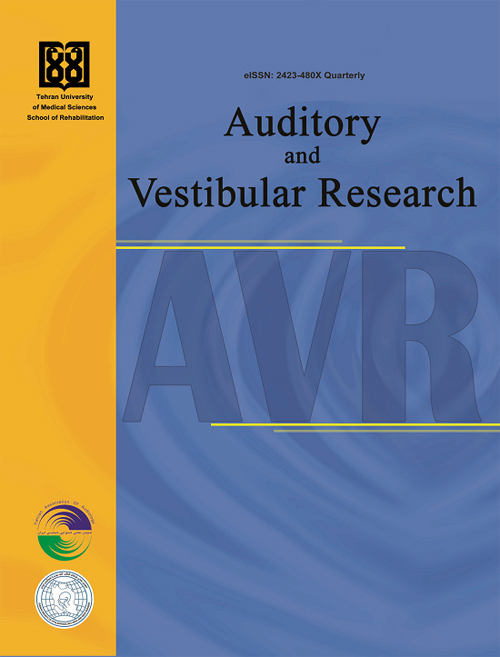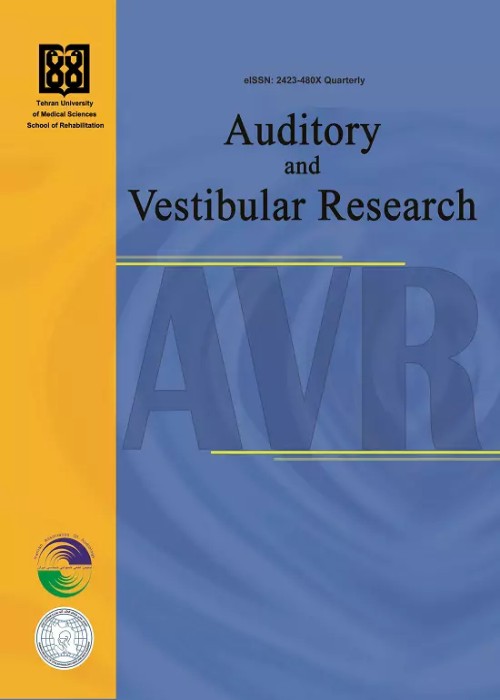فهرست مطالب

Auditory and Vestibular Research
Volume:28 Issue: 2, Spring 2019
- تاریخ انتشار: 1398/03/01
- تعداد عناوین: 8
-
-
Pages 62-74IntroductionThe vestibular system makes it possible to stabilize the head and body, spatial orientation, and gaze stability with processing of sensory inputs. There is much evidence that vestibular information is also involved in higher (cognitive) functions. For this purpose, in this article, we will review the impact of the vestibular system on memory as one of the cognitive functions.ResultsIn this overview, the search for related articles in the Google Scholar, Pubmed, Springer and Scopus databases was conducted with the key words of the vestibular system, memory, and cognitive functions. A total of 123 articles were found in this field, but because of their lack of direct relevance to the subject, repetition and oldness, only 70 articles that were written between 1989 and 2017 were used.
Clinical and laboratory findings indicate the association of vestibular inputs (beyond postural control and oculomotor) with a variety of higher functions, especially memory. Since part of the memory function is determined by other cognitive processes (i.e., attention, understanding, performance, motivation), the study of the effect of vestibular inputs on these functions provides a more accurate view of how the vestibular inputs affect memory performance.ConclusionAlthough current knowledge about memory-vestibular interactions is increasing, but why and how the vestibular signals are involved in memory representations is still limited and further studies are needed to determine the theoretical basis of vestibular involvement in the processing of memory.Keywords: Vestibular system, vestibular cor-tex, cognitive function, memory -
Pages 75-86Background and AimSpeech-auditory brainstem response (ABR) as a new test in the field of auditory electrophysiology, examines the auditory processing of stimuli with complex acoustic structures at the subcortical level. In recent years, speech-ABR has been administered to patients with various hearing impairments and people with special auditory skills. Results of these studies are of great interest to researchers in the fields of cognitive and auditory neurosciences. In this study, because of the increasing use of this test, a review of the studies carried out on the origin of this response and the proposed protocols to stimulate, record, and analyze this electrophysiological response are presented.Recent FindingsThe most common stimulus parameters used in the published articles was /da/ stimulus in 40 ms duration and 60-85 dB SPL intensity with the use of alternative polarity and rate of about 10 stimuli per second. The verified and widely-used acquisition parameters include using vertical electrode array with 6000 sweeps and a 30-3000 Hz filtering in a 60-70 ms time window.ConclusionIn determining the stimulus-record parameters of the speech-ABR test, in addition to considering the necessary minimums, the final values should always be selected based on the objectives and the study group. The unique features of this test for diagnosis and monitoring of auditory processing at supra-threshold levels, calls for comprehensive studies to formulate guidelines for the application of this test in auditory clinics but the basic points mentioned in this paper should be considered in the selection of each parameter.Keywords: Speech evoked auditory brainstem response, frequency following response, complex sounds
-
Pages 87-92Background and AimVestibular rehabilitation is suggested as one of the effective treatments for vestibular-originated dizziness and vertigo. As there is a proven biologic link between vestibular symptoms and headache, headache improvement with vestibular improvement after vestibular rehabilitation is expected. The aim of the present study was examining vestibular rehabilitation effects on dizziness and headache in 9−15 year old subjects with a vestibular migraine.MethodsEight subjects with vestibular migraine were referred to Rofeideh Rehabilitation Hospital after diagnosis by a pediatric neurologist. They were evaluated via dizziness handicap inventory (DHI), headache impact test-6 (HIT-6) and dizziness and headache frequency. Then they received a home-based vestibular rehabilitation and after one month they were reevaluated.ResultsAfter vestibular rehabilitation for one month, changes in the DHI and HIT-6 score were statistically significant (p < 0.01). In addition, reduction in the dizziness and headache frequency in a month was statistically significant.ConclusionAs vestibular rehabilitation has noticeable effects on dizziness and headache, this treatment is introduced as an effective and non-invasive treatment in children and adolescents with a vestibular migraine.Keywords: Vestibular migraine, children, adolescent, vestibular rehabilitation
-
Pages 93-99Background and AimAuditory-verbal memory and reading problems are frequently observed in patients with vestibular disorders, but rarely considered as a cognitive consequence of vestibular disease. Many clinicians do not recognize or ignore the psychological symptoms of vestibular disease. This approach could underestimate the cognitive problems of the patients, or even led to misdiagnosis of a combined vestibular-cognitive condition. The current study aimed to assess the cognitive impact of acute vestibular disorders.MethodsA total of 71 patients with unilateral vestibular neuritis, Meniere’s disease, and benign paroxysmal positional vertigo underwent a through audiologic evaluation, including otoscopy, pure tone audiometry, tympanometry, vestibular evoked myogenic potentials, videonystagmography plus caloric testing, and video head impulse testing in the plane of horizontal semicircular canals. After determination of the disease, the Persian version of the dizziness handicap inventory, the Persian reading test, and Rey auditory-verbal learning test were administered.ResultsThere were no significant difference between the patient groups with regard to their inabilities like reading and learning problems according to their auditory verbal memory score induced by acute vertigo. However, acute vertigo can reduce the reading ability and capacity of auditory-verbal memory of the patients compared with normal subjects.ConclusionUnilateral vestibular disorders in which patients suffer from acute rotatory vertigo could lead to reading difficulties and learning because of auditory-verbal memory impairment. The exact mechanism of vestibular impairment is not a determinant factor for these cognitive problems.Keywords: Vertigo, reading, auditory-verbal memory
-
Pages 100-105Background and AimBecause speech perception is disturbed in people who are exposed to noise, this study aimed to investigate the effect of work environment noise on working memory capacity, temporal, and dichotic auditory processing and relationship between them in elementary school teachers.MethodsFifty-six female aged 30−50 years were enrolled in our study case and control groups. A total of 28 teachers with normal hearing and poor speech perception in noise were in the case group, and 28 women were controls with normal hearing and good scores in speech perception in noise who did not work in a noisy environment. Working memory tests, dichotic digit test (DDT) and gap-detection test (GDT) were performed for both groups. The mean score of each test was obtained from the two groups and the results were analyzed.ResultsComparison of means between the two groups in DDT, GDT, and working memory capacity test showed that the scores of the case group were significantly lower than those in the control group (p < 0.05). There was no correlation between working memory capacity test, DDT, and GDT scores. (p > 0.05, r < 0.1).ConclusionNoise exposure in the work environment causes weakness in temporal and dichotic auditory processing, and working memory capacity. But there was no correlation between working memory capacity and auditory processing. The findings of this study show the effects of noise exposure on speech perception and the need to protect hearing from noise.Keywords: Noise, working memory, auditory processing, gap-detection, dichotic hearing
-
Pages 106-115Background and AimEarly experience, provide opportunity for later associative experiential learning by affecting multisensory systems. This phenomenon may because of the influences which sensory stimuli as sounds would have on non-auditory neural centers rather than just deploying hearing system, so the question is whether music as a kind of complex sound source, could help in general cognitive functions such as memory circuits or, conversely, it acts as a distracting factor. This study was investigated the effect of auditory experience with special kind of music, called polyphonic music, on auditory, visual and logical memories function.MethodsForty volunteers with normal hearing, aged 18 to 40 years, were participated in this experimental study. They were performed with Ray auditory verbal learning test, Kim Karad visual memory test, and Wechsler logical memory subtest in two states: no-music condition and music condition with a polyphonic piece as background music. Memory functions in these two conditions, and the effect of gender on performances, were compared between conditions.ResultsPolyphonic music significantly increased auditory, visual and logical memory performance compared with the no-music conditions (p < 0.05). No significant difference between genders was found in memory tasks in both music and no-music conditions (p > 0.05).ConclusionIt seems that presence of polyphonic music while people had enough auditory experience about it, impress memory performance. It is possibly owning to multisensory functions of brain and the effect of auditory experiences on cognitive system.Keywords: Auditory experience, polyphonic music, auditory-verbal memory, visual memory, logical memory
-
Pages 116-123Background and AimThe presence of a child with hearing impairment in the family is often problematic and needs psychological interventions. The purpose of this study was to investigate the effect of acceptance and commitment therapy (ACT) on the symptoms of anxiety and depression in mothers of hearing-impaired or deaf children.MethodsThis is a quasi-experimental study with pretest-posttest design and with experimental and control groups. The study population comprised all mothers of hearing-impaired or deaf children of 2–6 years old in Tabriz City, Iran. Using purposive sampling method, 32 mothers of hearing-impaired or deaf children were selected and then randomly assigned to control and experimental groups (each with 16 subjects). The experimental group was treated with ACT during 8 sessions of 1.5 hours long in two weeks. The study data were collected by the depression anxiety stress scale.ResultsACT was effective in decreasing anxiety and depression symptoms in mothers of hearing-impaired or deaf children (p < 0.05).ConclusionConsidering the results and effectiveness of ACT in reducing the symptoms of anxiety and depression in mothers of hearing-impaired or deaf children, this treatment is recommended in rehabilitation centers for children with hearing problems.Keywords: Depression_anxiety_acceptance - commitment therapy
-
Pages 124-133Background and AimInvestigations have shown that the patient’s attitudes toward hearing loss and hearing aids impact hearing aid benefits and its use. In this regard, Saunders and Cienkowski (1996) developed the “attitudes towards loss of hearing questionnaire” to examine some of the psychosocial factors underlying the use of hearing aids. This study has focused on preparing a Persian version of this questionnaire and analyzing its validity and reliability.MethodsThe original English version of the questionnaire was translated into Persian, and its content and face validities were determined by related experts. The final questionnaire was administered to 100 hearing impaired people (52 males and 48 females) aged 30 to 65 years with the mean (SD) age of 54.54 (12.05) years. The test-retest reliability was assessed in 20 patients.ResultsThe results of face validity assessment revealed that our questionnaire has a high quality in translation, intelligibility, and cultural compatibility. The mean scores of the content validity ratio and content validity index of this questionnaire was 0.71 and 0.98, respectively. The mean (SD) total score of this questionnaire was 60.46 (10.02) and the mean scores of denial of hearing loss, negative associations, negative coping strategies, manual dexterity and vision and hearing-related esteem were 15.58, 12.10, 20.40, 5.30, and 7.08, respectively. The overall Cronbach α value was 0.798. The test-retest reliability showed good results for the global score (Intraclass correlation = 0.989).ConclusionBased on the obtained results, the Persian version of the questionnaire possesses satisfactory validity and reliability.Keywords: Attitudes, hearing loss, questionnaire, hearing aid, reliability, validity


